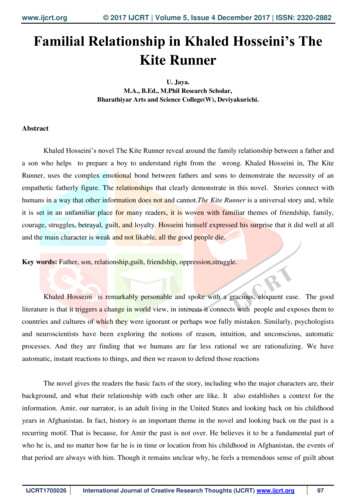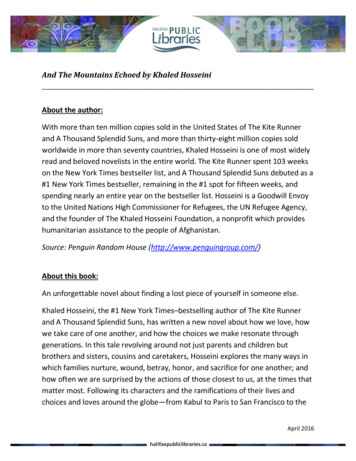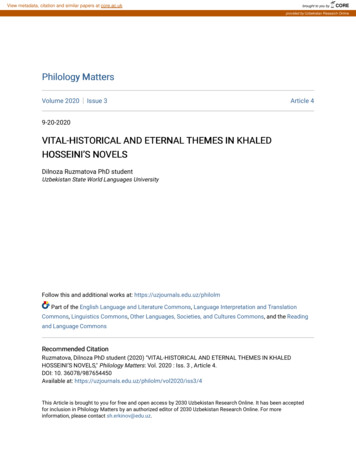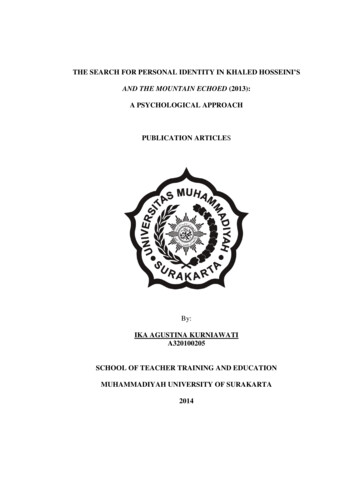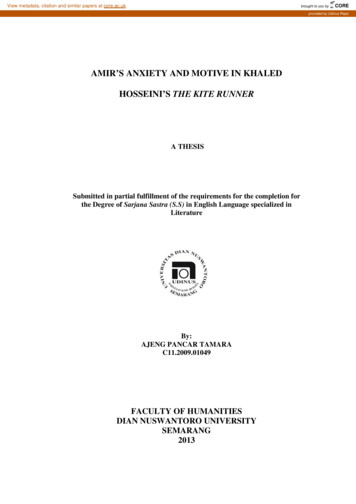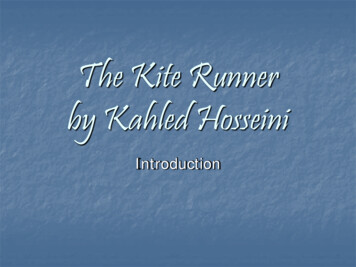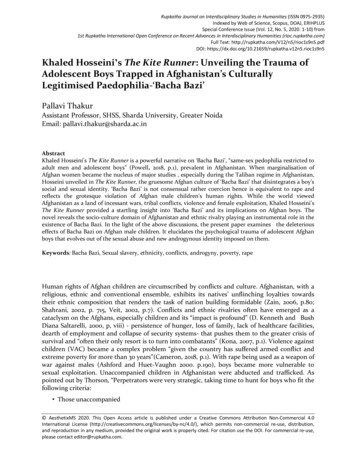
Transcription
Rupkatha Journal on Interdisciplinary Studies in Humanities (ISSN 0975-2935)Indexed by Web of Science, Scopus, DOAJ, ERIHPLUSSpecial Conference Issue (Vol. 12, No. 5, 2020. 1-10) from1st Rupkatha International Open Conference on Recent Advances in Interdisciplinary Humanities (rioc.rupkatha.com)Full Text: http://rupkatha.com/V12/n5/rioc1s9n5.pdfDOI: n5Khaled Hosseini’s The Kite Runner: Unveiling the Trauma ofAdolescent Boys Trapped in Afghanistan’s CulturallyLegitimised Paedophilia-‘Bacha Bazi’Pallavi ThakurAssistant Professor, SHSS, Sharda University, Greater NoidaEmail: pallavi.thakur@sharda.ac.inAbstractKhaled Hosseini’s The Kite Runner is a powerful narrative on ‘Bacha Bazi', “same-sex pedophilia restricted toadult men and adolescent boys” (Powell, 2018, p.1), prevalent in Afghanistan. When marginalisation ofAfghan women became the nucleus of major studies , especially during the Taliban regime in Afghanistan,Hosseini unveiled in The Kite Runner, the gruesome Afghan culture of ‘Bacha Bazi’ that disintegrates a boy’ssocial and sexual identity. ‘Bacha Bazi’ is not consensual rather coercion hence is equivalent to rape andreflects the grotesque violation of Afghan male children’s human rights. While the world viewedAfghanistan as a land of incessant wars, tribal conflicts, violence and female exploitation, Khaled Hosseini’sThe Kite Runner provided a startling insight into ‘Bacha Bazi’ and its implications on Afghan boys. Thenovel reveals the socio-culture domain of Afghanistan and ethnic rivalry playing an instrumental role in theexistence of Bacha Bazi. In the light of the above discussions, the present paper examines the deleteriouseffects of Bacha Bazi on Afghan male children. It elucidates the psychological trauma of adolescent Afghanboys that evolves out of the sexual abuse and new androgynous identity imposed on them.Keywords: Bacha Bazi, Sexual slavery, ethnicity, conflicts, androgyny, poverty, rapeHuman rights of Afghan children are circumscribed by conflicts and culture. Afghanistan, with areligious, ethnic and conventional ensemble, exhibits its natives’ unflinching loyalties towardstheir ethnic composition that renders the task of nation building formidable (Zain, 2006, p.80;Shahrani, 2002, p. 715, Veit, 2002, p.7). Conflicts and ethnic rivalries often have emerged as acataclysm on the Afghans, especially children and its “impact is profound” (D. Kenneth and BushDiana Saltarelli, 2000, p, viii) - persistence of hunger, loss of family, lack of healthcare facilities,dearth of employment and collapse of security systems- that pushes them to the greater crisis ofsurvival and “often their only resort is to turn into combatants” (Kona, 2007, p.1). Violence againstchildren (VAC) became a complex problem “given the country has suffered armed conflict andextreme poverty for more than 30 years”(Cameron, 2018, p.1). With rape being used as a weapon ofwar against males (Ashford and Huet-Vaughn 2000. p.190), boys became more vulnerable tosexual exploitation. Unaccompanied children in Afghanistan were abducted and trafficked. Aspointed out by Thorson, “Perpetrators were very strategic, taking time to hunt for boys who fit thefollowing criteria: Those unaccompanied AesthetixMS 2020. This Open Access article is published under a Creative Commons Attribution Non-Commercial 4.0International License (http://creativecommons.org/licenses/by-nc/4.0/), which permits non-commercial re-use, distribution,and reproduction in any medium, provided the original work is properly cited. For citation use the DOI. For commercial re-use,please contact editor@rupkatha.com.
2Rupkatha Journal, Vol. 12, No. 5, 2020 Those from unstable family backgrounds” (2013, p. 8).It has also been noticed that besides the exploitative nature of war, culture of a country can alsoset margins around its natives. According to Juan D. Delius culture is, “the ensemble of traditionalbehaviours that is characteristic of a population” (1991, p.76). As Kimbal Young states,” Thecultural world is the creation of man himself as he has learned how to manage nature and himselfthroughout his entire exist” (1931, p.19). So as man is the creator of culture, it might be rife withsome self-centric idiosyncrasies that might affect him socially, politically and economically.“What man does to culture appears to be as important and as compulsive as what culture does toman” (Wallis, 1950, p.44). Hence a culture can be progressive or regressive in nature. MargaritaAzevedo in The evaluation of the social impacts of culture: culture, arts and development exploresthe role of culture in the development of an individual, society and nation. Ac- cording to her‘cultural-based local dynamics’ plays a crucial role in “economic and social development, urbanregeneration and the quality of life” (2018, p.ix). However she also exemplifies that, “Beyond thispositive interpretation of culture as a difference maker for economic behaviour, it is also true thatculture can also act as a barrier when values and beliefs become obstacles to development of asociety” (ibid.,p.12). According to Albert, I. and G. Trommsdorff, “human development takes placein a given cultural context; it is affected by culture and it affects culture” (2014, p. 3). On the basisof the above discussions it can be concluded that a culture can affect a society in two ways: eitherit plays an instrumental role in its development or it restricts mental capabilities andempowerment of communities and can decelerate or stagnate its progress. Such restrictive andexploitative affect of culture on Afghan society are perceptible in Bacha Bazi that deals withsexual slavery of children in Afghanistan (Noman, 2016, p.501, 504).“According to the Afghanistan Independent Human Rights Commission (AIHRC),although there is no clear Afghan legal definition of bacha bazi, it generally refers to localpowerful individuals keeping one or more boys, typically between 10 to 18 years of age, foruse as body guards, servants, dancers, and for sexual exploitation and other forms ofharassment”(Special Inspector General for Afghanistan Reconstruction (SIGAR), 2018, p.1).End Child Prostitution and Trafficking (ECPAT) International mentions bacha bazi as a culturalpractice in Afghanistan where men use young boys for social and sexual entertainment (2014, p.13,p.47). According to Simone Borlie, it is culturally acceptable (2019, p.502) and thrives as acommunal practice in the country. Bacha bazi is rightly described by many commentators asAfghanistan’s “open secret”, demonstrating a way in which power is exercised and prestigeparaded as a cultural ideal for adult men, hiding the more sinister social reality of sexual slaveryand paedophilia (Powell, 2018, pp. 4-5). It involves a young boy who is either abducted or boughtfrom his family by an adult Afghan male. The boy is kept as a physical and sexual entertainer forthe caretaker and his adult male acquaintances. Also known as ‘Dancing Boys’, they also performas dancers at parties and weddings. (Thorson, 2013, p. 40; Kapur, Roshni, 2014; Mustafa Sarwar,2016). Zadzi quotes a Bacha Baaz for whom the public ostentation of bacha bazi is a sign ofprestige:“I am not really rich, but I am just as good as the wealthy. I want as many bacha bereesh aspossible, so that when I go to parties I am no worse than anybody else” (2007).As “the boy is a status symbol” for men (Schut, Michelle and Eva Van Baarle, 2017, p.80) they areready to pay a hefty amount to the child’s parents in exchange of his “services” (Noman 2016; 2016,Schut, Michelle and Baarle, Eva, 2017). Families which refuse to budge, before their clout, arethreatened. Bacha Baz selects those boys who are attractive and come from a poor family as thishelps in getting the boy under his “apprenticeship” and “ownership” (Oot, 2016). By the time the
3 Khaled Hosseini’s The Kite Runner: Unveiling the Trauma of Adolescent Boys Trapped inAfghanistan’s Culturally Legitimised Paedophilia-‘Bacha Bazi’boys reach the age of 18, the bacha baaz becomes disinterested in them and sets them free” (Oot2016; Borlie 2019). A lot of “contention exists regarding the legitimacy of bacha bazi under Islamiclaw” (Jones, 2015, p. 69). Many Afghans exhibit a strong opposition to Bacha Bazi ashomosexuality is not permissible in Islam (Jones, 2015, p.69). “Some traditions of the Prophetdisplay tolerance of homoerotic desires, others report the Prophet to have said that both theactive and the passive partner must be killed” (Schmidkte, 1999, p.260). Difference in opinion isalso seen regarding the existence of Bacha Bazi during the Taliban rule in Afghanistan. Someresearchers are of the opinion that Bacha Bazi was prohibited as it was considered against thepreachings of Islam and the perpetra- tors were stringently punished (McNally, Lauren and DavidAdesnik, 2015, p. 2) but after the collapse of the Taliban it revived and reinstated “with a violentexpression of Paedophilia” under the Mujahideens (Borile, 2019, p. 503). However someresearchers conclude that Taliban carried out Bacha Bazi secretly. As reported by the South AsianChannel, Taliban, “once came to power, bacha bazi became taboo, and the men who still engagedin the practice did so in secret (Mondloch, 2013). Through the above discussions it can beconcluded that conflicts and regressive culture dismantle the security systems of a society and asa result devastate the life of the indigenous. Its atrocious effects on children are explicitly visiblein the case of Afghanistan.Effects of Bacha Bazi on Adolescent Afghan BoysAn extreme form of repressive Afghan patriarchy, drenched in sexual perversity, reflects in BachaBazi. This pernicious culture decimates the mental capabilities of the victim and appropriates thesexual and gender identities of boys. Afghan society perceives the outwardly metamorphosis ofboys, into feminine attire and aping feminine gestures, as androgynous. This act of gendertransformation is done by adult males to silence any accusation of perpetrating homosexualviolence as “the sexual act is consummated with persons whose sexual identity is no longermasculine but is a new one, culturally perceived as androgynous” (Borile, 2019, p.502). Society’srepugnancy, towards their being sexually exploited and developing feminine traits, adds to theirisolation. The victims belonging to minority ethnic groups face double marginalization: first forbeing a boy and secondly for being born in a rival ethnic community. With lack of thepsychosocial support, the victims are unable to vanquish the horrors of their past. “And oncebranded as men who danced as women, there is no turning back” (Abawi, 2009). Due to socialisolation, the victims have low level of self-esteem and self-respect (Stephen, 2015). In some cases,the victims were murdered by their families for tarnishing the honour whereas some committedsuicide because of the shame, insult and humiliation associated with their past (Schut, Michelleand Eva Van Baarle, 2017, p.94). A few victims of Bacha Bazi, after experiencing the sexualperversity of male adults, get a new understanding of male sexual appetite which becomes aninherent trait of their personality and makes them vindictive as an adult. Hence theirpsychological trauma is pacified only when they revisit their pain on another victim and the cycleof abuse perpetuates (Stephen, 2015). In some cases it has been reported that Bacha Baaz inflictedphysical injuries on the boys:most cases result in some form of grievous physical injury due to rape trauma includinginternal/anal haemorrhaging, rectal prolapse, protrusion of intestines, displaced pelvisbones, throat injuries, heavy internal bleeding, rectal wall tearing, as well as in- juries thatstem from the pure force of coercion. These include broken limbs, broken fingers,fractures, broken teeth, savage beatings, strangulation, asphyxiation, and in some casesdeath.” (Stephen 2015).
4Rupkatha Journal, Vol. 12, No. 5, 2020Concerning Khaled Hosseini’s The Kite Runner, the paper examines how Afghan boys suffer in thevicious vortex of Bacha Bazi because of the persisting patriarchy and ethnic rivalry betweenPashtuns and Hazaras. The novel underscores Pashtuns indulging in Bacha Bazi with a dualpurpose: to avenge the losses incurred on their race by Hazaras and to fulfil their thirst for sexualgratification. Barat Ali Jafar writes in Afghan Child Labourers Exposed to Abuse about the concernof Esmatullah Nasari, who runs Empowerment Centre for Women, on Bacha Bazi. He states, “Theabuse of children by those in position of power appears to have become an unpleas- ant aspect ofAfghan culture” (2017). He further reiterates, “If this issue of sexual assault is not stopped in itstracks it could spread and can have very dangerous consequences on our country” (Ibid.)Khalid Hosseini ’s The Kite Runner: Unveiling Bacha Bazi as Social, Cultural andPsychological DecadenceThe Kite Runner encompasses Afghanistan’s history in a nutshell. It is a window to the socialcomplexities, political upheavals, and racial discrimination emerging out of the chaotic conditionsprevailing during Taliban regime. Afghanistan, with multi-ethnic fabric, has always beenstruggling with the crisis of racism and creating the ideology of a nation. The growing affinity andpride towards the ethnicity, aggravated intolerance amongst the ethnic groups in the Afghansociety. According to Omar Farooq Zain in Afghanistan: From Conflict to Conflict “ethnic affinitiesand identities remain high even after the unpleasant development of the last two and a halfdecades in Afghanistan”(2006, p. 82). Khalid Hosseini made a groundbreaking attempt in The KiteRunner by unveiling the plight of Hazaras, a minority ethnic group in Afghanistan, due to theexisting racism. It presents the victimisation of the Hazara children who are drawn into BachaBazi by the Pashtun warlords to satiate their bitterness against the rival ethnic group. The novelintricately weaves the traumatized lives of Hazaras in the Pashtun dominated Afghan society andexposes the Pashtun warlords using Bacha Bazi to fulfill their dual objectives: to satiate the sexualurges and to accomplish the task of ethnic cleansing.The story revolves around Hassan (a Hazara) who being an inquisitive child has a naturalinclination towards inquiry and learning. Raised in Amir’s family (a Pashtun), the latter wassurprised the way Hassan understood the people he was around with and the situation he wasplaced in. Amir’s father, Baba, was an affluent, renowned Sunni Pashtun who “was used towinning, winning at everything he set his mind to” (Hosseini, A Kite Runner, p.52). As thechildren grew together, Amir was shocked to learn about the atrocities and discriminationinflicted on Hazaras in Afghanistan. His curiosity to know about Hazaras grew when he watchedAli (Hassan’s father) being chased and mocked by the children on the streets of Kabul. Theychided him and called him, ”flat-nosed” because of Ali and Hassan’s peculiar Hazara Mongoloidfeatures” (Ibid, p.8). As a child he was oblivious to the revulsion the Pashtuns had againstHazaras. He failed to understand his superiority as a Pashtun and Hassan’s inferiority as a Hazara.Baba and Amir always treated Ali and Hassan as family members and they were neverdiscriminated on the basis of their race. However the society’s restrictions on the Hazaras deniedHassan admission in a school. Amir’s queries related to the persisting hatred for Hazaras amongstthe Pashtuns were not resolved. The only idea he had about Hazaras was that “they were Moguldescendants and that they looked a little like Chinese people” (Ibid, p.8). His quest for Hazarasand Pashtuns’ animosity ended when he found one of his mother’s history books in the library ofhis Baba. His world of innocence got replaced by the abysmal world of barbarity and oppression.Amir expounds after reading an entire chapter on Hazaras’ history:
5 Khaled Hosseini’s The Kite Runner: Unveiling the Trauma of Adolescent Boys Trapped inAfghanistan’s Culturally Legitimised Paedophilia-‘Bacha Bazi’“I read that my people, the Pashtuns, had persecuted and oppressed the Hazaras. It saidthe Hazaras had tried to rise against the Pashtuns in the nineteenth century, but thePashtuns had “quelled them with unspeakable violence.” The book said that my peoplehad killed the Hazaras, driven them from their lands, burned their homes, and sold theirwomen. The book said part of the reason Pashtuns had oppressed the Hazaras was thatthe Pashtuns were Sunni Muslims, while Hazaras were Shi’a” (Ibid, pp.8-9).Hassan, as a hazara, faces the brunt of being born in a minority group. The world ofdiscrimination, hatred, marginalization and trauma opens up to him after his encounter withAseef. The latter was intolerant to Hazaras hence often addressed Hassan as a “donkey”. Aseef’shatred against the Hazaras is explicitly visible when he claims Afghanistan as a land of Pashtuns.Presence of Hazaras was quite repugnant to him so he proposes to meet the president and makeAfghanistan bereft of the “dirty, Kassef Hazaras”. Amir is severely castigated by Aseef for takingin Hassan as a family. He reprimands Amir, “If idiots like you and your father didn’t take thesepeople in, we’d be rid of them by now. They’d all just go rot in Hazarajat where they belong.You’re a disgrace to Afghanistan” (Ibid, p. 39). He expresses his vision:“Afghanistan is the land of Pashtuns. It always has been, always will be. We are the trueAfghans, the pure Afghans, not this Flat-nose here. His people pollute our home- land, ourwatani. They dirty our blood.” He made a sweeping, grandiose gesture with his hands.“Afghanistan for Pashtuns, I say. That’s my vision” (Ibid, p. 38).Hassan could never fathom the repercussion of his attempt to save Amir. His act of protectingAmir from the invincible leader, Aseef, undesirably challenged the latter. The wounded Aseefwarns Amir and Hassan, “Your Hazara made a big mistake today, Amir” (KR 40). His squashedego craved to take vengeance. Aseef’s idiosyncratic and perverted ideologies for the Hazaras madehim sexually abuse Hassan. His act of sexual violence against the subaltern child is a testimony tohis sadistic nature and intense desire to cleanse Afghanistan of the minorities who, he believed,are corrupting Afghanistan’s valuable culture, tradition and ethnicity. Amir remembers the winterof 1975 when he “saw Hassan run a kite for the last time” (Ibid, p. 51). Amir won the kitetournament but the last kite had to be produced as a symbol of victory and was also considered asa prized possession. Hassan, the greatest kite runner runs to grab the kite for his ardent masterand friend, Amir. As soon as he reached for the kite, he found himself trapped by Aseef and hisfriends in an alley. Desperate Aseef was eagerly waiting for the opportunity. After a briefconfrontation between the two, Aseef sexually abuses him:Aseef knelt behind Hassan, put his hands on Hassan’s hips and lifted his bare but- tocks.He kept one hand on Hassan’s back and undid his own belt buckle with his free hand. Heunzipped his jeans. Dropped his underwear. He positioned himself behind Hassan. Hassandidn’t struggle. Didn’t even whimper. He moved his head slightly and I caught a glimpseof his face. Saw the resignation in it. It was a look I had seen before. It was the look of thelamb (Ibid, p. 71).Amir watched the episode as a naïve spectator and didn’t barge in to save Hassan as he was scaredof what he could do to him. He expatiates on his act of running away from the alley,“I ran because I was a coward. I was afraid of Aseef and what he would do to me. I wasafraid of get- ting hurt” (Ibid, p. 72). To console and comfort his guilt he justifies hiscowardice act as, “He was just a Hazara, wasn’t he?” (Ibid, p. 73)Here, Amir appears to consider Hassan as a mere Hazara servant who is bound to serve the
6Rupkatha Journal, Vol. 12, No. 5, 2020superiors. The novel expounds the effect of racism on children’s psyche which turns them into amonstrous aggressor. The beginning of the novel, The Kite Runner, describing the sexual assaulton a Hazara boy, divulges the extent of abhorrence and detestation thriving in Afghanistanagainst the minorities, especially for the Hazaras. It also lays bare the fact that children wereraped and sexually exploited by the men in power and their community. Even Amir clearlyunderstood the chasm between Pashtuns and Hazaras:The curious thing was, I never thought of Hassan and me as friends either. Not in theusual sense anyhow. Never mind that we taught each other to ride a bicycle with nohands, or to build a fully functional homemade camera out of a cardboard-box Nevermind any of those things. Because history isn’t easy to overcome. Neither is religion. In theneed, I was a Pashtun and he was a Hazara, I was Sunni and he was Shi’a, and nothing wasever going to change that. Nothing (Ibid, p. 24).As the story proceeds, the readers find to their dismay, Hassan’s son, Shorab, trapped in BachaBazi under the Bacha Baz, Aseef. Amir, who moved to America due to the growing insecurities inAfghanistan, returns to his native land on the call of Rahim Khan, his father’s friend. On meetinghim, Amir finds that Hassan and his wife have been killed by the Talib’s and his son, Shorab, livesin “an orphanage somewhere in Karteh-She” (Ibid, p. 203). Amir who has been heavily laden withguilt since his childhood for not protecting Hassan from Aseef, decides to provide Shorab with adecent life. On reaching the orphanage, the owner of the orphanage, Zaman, informs Amir thatShorab has been taken away by a Talib official who, “visits once every month or two. He bringscash with him, not a lot, but better than nothing at all” (Ibid, p.235). Zaman also expresses hisinability to protect the children of the orphanage from the powerful warlord,“If I deny him one child, he takes ten. So I let him take one and leave the judging on Allah”(Ibid, p. 237). The novel reveals the reticent submission of the Afghans before the Talibs.He also informs that “Usually he will take a girl, but not always” (Ibid, p.235).This reflects the Talibs extreme indulgence in satisfying his sexual gratification through children.Zaman ex- presses his helplessness when he says,I swallow my pride and take his goddam filthy dirty money. Then I go to the bazar andbuy food for the children” (Ibid, p.237).The novel exhibits powerlessness and poverty responsible for the spread of Bacha Bazi inAfghanistan. Beleaguered Afghans watched children being treated as commodities; mistreatedand abused.Amir finds Shorab turned into a dancing boy by the Taliban warlord, who was no one else butAssef. Aseef’s immense hatred which he carried against the Hazaras didn’t diminish a bit and anadult. Kenneth D. Bush Diana Saltarelli in The Two Faces of Education in Ethnic Conflict commenton the research undertaken by Padilla, Ruiz and Brand (1974) that ethnic attitudes with positive ornegative prejudices, develop in human beings in the early years of their life which increases withtime (2000, p.3). Shorab cladded as a woman, was brought before the Talib. He was “dressed inloose, sapphire blue pirhan-tumban” (Hosseini, 2013, p.256).“His head was shaved, his eyes darkened with mascara, and his cheeks glowed with anunnatural red. When he stopped in the middle of the room, the bells strapped around hisanklets stopped jingling” (Ibid,p. 257). The description highlights the restructuring of a male child’s sexual identity in BachaBazi. It also exhibits Pashtuns revelling in Bacha Bazi who were known for savagely punishing
7 Khaled Hosseini’s The Kite Runner: Unveiling the Trauma of Adolescent Boys Trapped inAfghanistan’s Culturally Legitimised Paedophilia-‘Bacha Bazi’homosexuality. According to Mondloch “Pashtun social norms dictate that bacha bazi is notunIslamic or homosexual at all” (2013). Shaista Gohir, in her article The hypocrisy of child abuse inmany Muslim countries comments on the culture of Bacha Bazi that is prevalent in many Muslimcountries of the world,“The moral hypocrisy is outrageous in a country where homosexuality is not only strictlyforbidden but savagely punished, even between two consenting adults. However, menwho sodomize young boys are not considered homosexuals or paedophiles” (2010).Amir comments, “I guessed the music wasn’t sinful as long as it played to Taliban ears” (Hosseini,2013, p.257). Amir watched Hassan dance in front of the Talibs:Sohrab raised his arms and turned slowly. He stood on tip-toes, spun gracefully, dipped tohis knees, straightened, and spun again. His little hands swivelled at the wrists, his fingerssnapped, and his head swung side to side like a pendulum. His feet pounded the floor, thebells jingling in perfect harmony with the beat of the table. He kept his eyes closed (Ibid,p. 257).Sohrab seems to be enveloped by humiliation and fear in such an abysmal condition. As a child,he is not only harmed physically but also psychologically. The presence of the Talib scares himand instills him with the horrors of sexual assault. Shorab represents the plight of Hazara boyswho are poor orphans and hence are easily accessible to the warlords. Amir could explicitly seethe sensual advances made by the Talib towards Sohrab. The puny child standing head downexpresses his silent acquiescence to the indecent advances of the Warlord. His reference toShorab as ‘my Hazara boy’ affirms his treatment of the child as his possession.“Bia, bia, my boy,” the Talib said, calling Sohrab to him. Sohrab went to him, head down,stood between his thighs. The Talib wrapped his arms around the boy. “How talented heis, nay, my Hazara boy!” he said. His hands slid down the child’s back, then up, felt underhis armpits. One of the guards elbowed the other and snickered” (Ibid, pp. 257-58).Talib’s fondling of Shorab’s body displays his sexual perversity. Hosseini has presented the Hazarachildren being trapped in Bacha Bazi and sexually exploited due to the existing rivalry betweenthe two ethnic groups. The novel uncovers the unflinching desire of the Pashtuns to remove everyspeck of Hazaras’ existence from Afghanistan. Aseef, the Talib, expounds the reason behind thedecision of Pashtuns to cleanse Afghanistan, “Like pride in your people, your customs, yourlanguage. Afghanistan is like a beautiful mansion littered with garbage, and someone has to takeout the garbage” (Ibid, p.261). The statement explicitly reflects the unbending hatred of Pashtunsfor Hazaras and other ethnic groups that led to blood-baths, massacres, savagery and ruthlessnessin Afghanistan. According to Muhammad Hussain Nusrat, “The act of “ethnic cleansing, landconfiscation, slavery and persecution’ has been carried out against Hazaras “since 1891” (2019, p.1).Ethnic hatred subjected children to sexual assault and violence. Amir questions Aseef’s for hisobdurate determination:“What mission is that?” I heard myself say. “Stoning adulterers? Raping children? Floggingwomen for wearing high heels? Massacring Hazaras? All in the name of Islam? ( Hosseini,2013, p. 261).The novel depicts ethnic rivalry as one of the reasons for the existence of Bacha Bazi. According toKenneth D. Bush and Diana Saltarelli the ethnic group in majority employs various strategies todominate the ethnic groups in minority, “Their strategies include scorched earth tactics to starvepopulations and destroy infrastructures, sexual torture and mass rape, ethnic and social cleansing,
8Rupkatha Journal, Vol. 12, No. 5, 2020and even genocide” (2000, p.4). Be- sides highlighting the impact of ethnic rivalry on Hazara malechildren, the novel also under- scores the psychological impact of Bacha Bazi on Shorab who triesto commit suicide being fearful of the notion that he would be sent back to the orphanage andperhaps he would again be placed in the vicious cycle of sexual slavery. Amir recalls Shorab’s bodyfloating in the bath tub of the hotel room, “the water drops dripping from the faucet anddangling over the side of the tub, the blood-soaked razor sitting on the toilet tank and his eyes,still half open but lightless” (Hosseini, 2013, p.318). Though Amir succeeds in taking Shorab alongwith him to USA, the latter continues to live a life of recluse. Amir sums up his silence as, “It wasthe silence of one who has taken cover in a dark place, curled up all the edges and tucked themunder” (Ibid, p.331). Amir and Soraya (Amir’s wife) make myriad efforts to bring Shorab back tohis normal life but failed miserably. The novel ends on a positive note when Amir finally gets asuccess in lighting a spark in the eyes of Shorab through the kite flying activity organised at agathering of Afghans at Fremont. Though initially Shorab hesitated to join the activity but soonAmir found him participating in the event. The repetition of 'kite flying competition’ at the end ofthe novel reminds the readers of the incident when Amir saw Hassan, the eponymous Kiterunner, “run a kite for the last time” (Ibid, p.51). The novel in the end depicts Amir taking over therole Has- san played in his life. Now Amir was the ‘Kite Runner’ who was trying to win back thelost life of Shorab. “For you, a thousand times over,” I heard myself say” (Ibid, p. 340). The endlends a powerful hope that Shorab will gradually recuperate from his despicable state. Hosseini’sThe Kite Runner voices the plight of thousands of Afghan male children who are trapped in thedeep- rooted culture of Bacha Bazi. The novel also suggests that people need to act against theauthoritative and intimidating power structures that try to dominate the society through theiroppressive norms. Any culture that is exploitative in nature and denies people of their humanrights shouldn’t be cradled rather discarded. Bacha Bazi is affecting Afghanistan in two ways:restricting the healthy development of male Afghan children who are t
Khaled Hosseini's The Kite Runner is a powerful narrative on 'Bacha Bazi', "same-sex pedophilia restricted to adult men and adolescent boys" (Powell, 2018, p.1), prevalent in Afghanistan. When marginalisation of Afghan women became the nucleus of major studies , especially during the Taliban regime in Afghanistan, Hosseini unveiled in The Kite Runner, the gruesome Afghan culture of .
